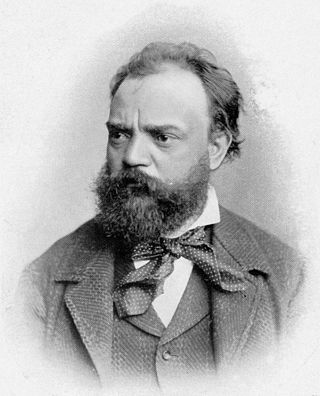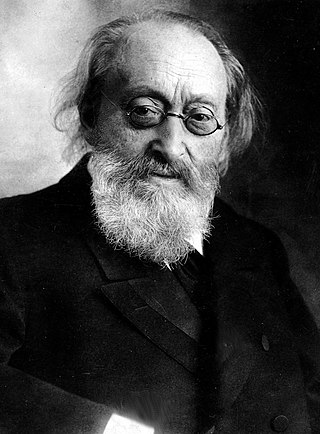Shulamit Ran is an Israeli-American composer. She moved from Israel to New York City at 14, as a scholarship student at the Mannes College of Music. Her Symphony (1990) won her the Pulitzer Prize for Music. She was the second woman to win the Pulitzer Prize for Music, the first being Ellen Taaffe Zwilich in 1983. Ran was a professor of music composition at the University of Chicago from 1973 to 2015. She has performed as a pianist in Israel, Europe and the U.S., and her compositional works have been performed worldwide by a wide array of orchestras and chamber groups.
John Harris Harbison is an American composer and academic.

The Symphony No. 5 in F major, Op. 76, B. 54, is a classical composition by Czech composer Antonín Dvořák. It was originally published as Symphony No. 3.

The Concerto for Clarinet, Viola, and Orchestra in E minor, Op. 88, is a composition by Max Bruch which was composed in 1911. It premiered on 5 March 1912 in Wilhelmshaven by the piece's dedicatees, violist Willy Hess and the composer's son and clarinet soloist, Max Felix Bruch. The score however was published 23 years after the composer's death, finally being released in 1942.

Lior Navok is an Israeli classical composer, conductor and pianist. He was born in Tel Aviv. Navok studied composition privately with the Israeli composer Moshe Zorman, and completed a Bachelor's degree at the Jerusalem Academy of Music and Dance, where he studied composition and conducting. He later completed he studied for a Master's and Doctorate at the New England Conservatory, where he studied with John Harbison.
Symphony No. 1 is a symphony in one movement by the American composer Christopher Rouse. The work was commissioned by David Zinman and the Baltimore Symphony Orchestra, completed on August 26, 1986, and premiered in Baltimore, January 21, 1988. The piece is dedicated to Rouse's friend and fellow composer, John Harbison.
The Boston Concerto is a concerto for orchestra by the American composer Elliott Carter. The work was commissioned by the Boston Symphony Orchestra, for which the piece is titled. It was first performed in Symphony Hall, Boston, on April 3, 2003 by the Boston Symphony Orchestra under the conductor Ingo Metzmacher. Carter dedicated the concerto to his wife Helen Jones Carter, who died on May 17, 2003.
Charles Clement Fussell is an American composer and conductor of contemporary classical music. He has composed six symphonies and three operas. His symphony Wilde for solo baritone and orchestra, based on the life of Oscar Wilde and premiered by the Newton Symphony Orchestra and the baritone Sanford Sylvan in 1990, was a finalist for the 1991 Pulitzer Prize for Music. He received a citation and award from the American Academy of Arts and Letters in 1992.
The Symphony No. 6 is a composition for mezzo-soprano solo and orchestra by the American composer John Harbison. The work was commissioned by the Boston Symphony Orchestra under the conductor James Levine. It was composed in 2011 and was given its world premiere in Boston on January 12, 2012 by the mezzo-soprano Paula Murrihy and the Boston Symphony Orchestra under the direction of David Zinman. The piece is dedicated "in friendship and gratitude" to James Levine, who would have conducted the premiere had he not retired from his post as the music director of the Boston Symphony Orchestra due to health concerns.
The Symphony No. 5 is a composition for baritone, mezzo-soprano, and orchestra by the American composer John Harbison. The work was commissioned by the Boston Symphony Orchestra under the conductor James Levine. It was given its world premiere in Boston on April 17, 2008, by the mezzo-soprano Kate Lindsey, the baritone Nathan Gunn, and the Boston Symphony Orchestra directed by James Levine. The text of the piece is set to Orpheus and Eurydice by Czesław Miłosz, Relic by Louise Glück, and the Sonnets to Orpheus by Rainer Maria Rilke.
The Symphony No. 4 is an orchestral composition by the American composer John Harbison. The work was commissioned by the Seattle Symphony with contributions from the philanthropists Richard and Constance Albrecht. It was given its world premiere in Seattle on June 17, 2004 by the Seattle Symphony under the direction of Gerard Schwarz.
The Symphony No. 2 is an orchestral composition by the American composer John Harbison. The work was commissioned by the San Francisco Symphony for its 75th anniversary. It was composed in 1987.
The Symphony No. 3 is an orchestral composition by the American composer John Harbison. The work was commissioned by the Baltimore Symphony Orchestra under the conductor David Zinman for the orchestra's 75th anniversary. It was given its world premiere on February 26, 1991 by the Baltimore Symphony Orchestra directed by Zinman. The piece is dedicated to Harbison's friend and fellow composer Christopher Rouse.
The Oboe Concerto is a composition for solo oboe and orchestra by the American composer John Harbison. The work was commissioned by the San Francisco Symphony for its principal oboist William Bennett. It was completed on October 18, 1991, and was given its world premiere by Bennett and the San Francisco Symphony under the conductor Herbert Blomstedt in 1992.
The Double Concerto for Violin and Cello is a double concerto for violin, cello, and orchestra by the American composer John Harbison. The work was commissioned by the Friends of Dresden Music Foundation for the Boston Symphony Orchestra under the conductor James Levine. It was given its world premiere on April 8, 2010, by the spousal team of the violinist Mira Wang and the cellist Jan Vogler and the Boston Symphony Orchestra under the direction of Carlos Kalmar. The piece was composed in honor of the violinist Roman Totenberg.
The Concerto for Piano and Orchestra is a piano concerto by the American composer John Corigliano. The work was commissioned by the San Antonio Symphony and was first performed on April 7, 1968, by the pianist Hilde Somer and the San Antonio Symphony under the direction of Victor Alessandro. The piece is dedicated to John Atkins.
The Concerto for Viola and Orchestra is a viola concerto by the American composer John Harbison. The work was commissioned by the Saint Paul Chamber Orchestra, the Los Angeles Chamber Orchestra, and the New Jersey Symphony Orchestra with contributions from Meet The Composer and Reader's Digest. It was first performed by Jaime Laredo and the New Jersey Symphony Orchestra under the direction of Hugh Wolff on May 18, 1990.
The Requiem is a composition for soprano, mezzo-soprano, tenor, baritone, chorus, and orchestra by the American composer John Harbison. Composed over a period of seventeen years, the complete work was finished in 2002 on a commission from the Boston Symphony Orchestra. Its world premiere was given by the soprano Christine Brewer, mezzo-soprano Margaret Lattimore, tenor Paul Groves, baritone Jonathan Lemalu the Tanglewood Festival Chorus, and the Boston Symphony Orchestra under the direction of Bernard Haitink on March 6, 2003.
The Concerto for Piano and Orchestra is a musical composition by the American composer Aaron Copland. The work was commissioned by the conductor Serge Koussevitzky who was then music director of the Boston Symphony Orchestra. It was first performed on January 28, 1927, by the Boston Symphony Orchestra conducted by Koussevitzky with the composer himself as the soloist. The piece is dedicated to Copland's patron Alma Morgenthau Wertheim.
Russian composer Alfred Schnittke's Symphony No. 7 was composed in 1993. It is dedicated to conductor Kurt Masur who gave its world premiere performance in New York with the New York Philharmonic Orchestra on 10 February 1994.


